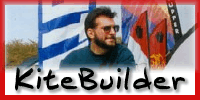
Rokkaku6 (rokkaku6@aol.comno.spam)
writes to rec.kites:
Can anyone tell me what this quote from the AKA rule book means:
"ROKKAKUS ? Rokkaku kites must be six-sided and framed as
traditional Sanjo-style Rokkaku. These kites are taller than they
are wide and their cross spars are traditionally bowed. " I
looked all over for a definition of "Sanjo-style
Rokkaku", but can't come up with a definition. I've seen
pics, but they don't all match the drawings in the rule book, or
each other. Are all of the drawings in the AKA rule book
"Sanjo-style Rokkakus?" (and if not, why are they in
the rule book?) Does "Sanjo-style Rokkaku" refer to a
3-4-5 , 4-5-6 or other ratios? Or to all of them? Thanks for your
help.
************************************************
Replies:
************************************************
Sanjo Rokkaku's are a traditional Japanese kite, (Sanjo is the place they are from) many japanese kites are named after their place of origin. The traditional frame style would be with three spars 1 the spine( the longest spar) which runs from top to bottom 2&3 the cross spars these are bowed. ( these are of equal length) That's it nothing very complicated really the 345 or 456 is down to personal preference. Just to confuse matters a little and probably why the rules are so specific, there are other styles of rokkaku (which simply means six sided ) some Japanese Rokkaku kites also have three cross spars, but these tend to have a lower aspect ratio. Charlie Charlton
A quote from "The complete Rokkaku kite chronicles and
traing manual" an
America publication that covers all rules from the states and
europe.
"a classic rokkaku works out to about five units wide by six
units
tall. the cross spars are located at points about 1.25 units of
the spine's
length within each end of the spine".
so this gives a ratio of 3.5/5/6!
stick to something of this range (or the other two) and it'll be
accepted,
if you make it too far out then you may find it not considered
acceptable.
regards, Peter Dawson.
Look here at this Japanese site (In English) it is a page
about
the city of Sanjo
http://www.city.sanjo.niigata.jp/public/eng/pg6-1e.html
Charlie
I am Japanese kite flier.
Rokkaku means six angle. Roku means six andn kaku means angle.
They call Rokkau as Sanjo Makiika in Sanjo.
There are ten kinds of the size of traditional Rokkaku according
to hte
number of sheets which are used in a kite.
The smallest kite has the size of 55cm(height)x44cm(width) and
the largest
kite has the size of 5.15m(height)x4.12m(width).
Masami Takakuwa et3m-tkkw@asahi-net.or.jp
I've been to Sanjo and seen these kites. The line pullers are
anchored to the ground and are about 5 feet long and about 4
inches in diameter ( the wooden shank) The kites themselves have
rubber hoses on the bottom of the spine so they don't impale
people. As it is sometimes people get hurt. These are really big
kites flown across the river to do battle. The teams are often
5-10 people..but the wind is not very strong there most of the
time. bob harris http://www.bhc.com
you can see a lot about japanese kite battles on my website..